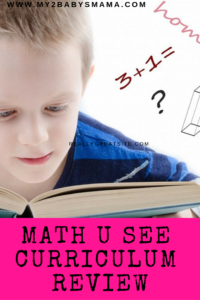Math U See Curriculum Review
In my seven years of homeschooling I have used two different math curriculums. In kindergarten we used Saxon Math, and then we switched to Math U See. I fell in love with it almost immediately. It presents the information in a comprehensive fashion with each level building on the previous one. It uses manipulatives to help teach the math facts, and it provides numerous resources to assist a child in learning.

- “This post contains affiliate links, which means I receive a small commission, at no extra cost to you, if you make a purchase using this link”
Math U See is a product of Demme Learning, founded by Steven Demme. Steven Demme taught high school math, and then went into middle school and upper elementary to teach math. Throughout his years of teaching, he discovered that most students knew the basic math processes, but were unable to explain why they work or what operation to use in order to figure out a problem. So he wrote this curriculum to teach not only the math operations, but the why behind how they work.
Most math curriculum follows a grade level, for example, kindergarten, first, second, etc. Math U See is different in that it follows concepts, not grade levels. These are the main concepts of each Math U See level:
Basic Math:
-Lower Elementary
- Primer – an introduction to math in which the student learns numbers, place value, and basic addition and subtraction
- Alpha – this level expands the student’s understanding of place value and creates fluency with all of the basic addition and subtraction facts. It also introduces halves and quarters, teaches time to the hour and minute, and counting by 2’s, 5’s, and 10’s.
- Beta – this level focuses on adding and subtracting any numbers fluently, expanding on understanding larger place values and using math to solve real world problems.
- Gamma – in this level the student will learn how to skip count and multiply. Basic multiplication facts are learned and then applied to multiple digit multiplication.
-Upper Elementary
- Delta – the main focus of this level is division. It builds on what is learned in the previous levels and uses the multiplication facts and practice to teach understanding of division. By the end of this level, the student will have learned how to divide any size number. This level also relates division to fractions and introduces fraction concepts. It also includes an introduction to geometry.
- Epsilon – this is all about fractions. Each student will learn how to multiply, divide, add, and subtract all fraction forms, and how to use mixed numbers and improper fractions. This level also introduces the relationship between fractions and decimals.
- Zeta – in this level the student will learn about decimals and percentages and how to work core functions with decimals.
Secondary Math:
- Pre-algebra – in this level the student deals with adding, subtracting, multiplying, and dividing both positive and negative numbers; working with the order of operations.
- Algebra 1 – the student works with linear and quadratic equations, further work with exponents, and adding, multiplying, and dividing polynomials.
- Geometry – this level teaches basic geometric concepts including points, lines, rays, segments, angles, proofs, theoroms, and more. The student will learn how to find the area and volume of solids and use the Pythagorean theorem to identify triangle attributes.
- Algebra 2 – This level expands the algebra concepts in Algebra 1 (a lot of things I don’t understand, because this is above my understanding. 🙂
- Pre-calculus – This level introduces trigonometry and polar equations to prepare the student for calculus.
- Calculus – this level involves solving differential equations, derivatives and calculus operations.
Right now, Super Stuffy is in the last third of the Epsilon book, and Bear Bear has finished the Gamma book. Even though the Math U See curriculum does not follow grade levels, these books generally coincide with the fifth/sixth grades, and third grades, respectively.
What I Love about Math U See
There are many things to love about Math U See. Since the curriculum does not necessarily follow grade levels, you are free to take as much time as you need on a particular lesson or concept so that your child can master it before you move on. For example, Super Stuffy has a talent for math, so he is able to learn the lesson easily. I have him do the lesson test on the same day as the lessons and he has no problems. However, Bear Bear has a little more difficulty understanding the concepts, so we can take as much time as we need. Right now we are taking our time learning the multiplication tables in order that she can master them.
In addition to being able to take your time, there are many wonderful resources that Math U See provides. Some of my favorites are the manipulative blocks and the lesson DVD’s. But some other resources include:
Basic curriculum sets:
- Each set comes with the teacher manual which has a complete answer key for all workbook and test booklets.
- A student workbook in which there are 3 or 4 different practice pages for each lesson. This gives you the flexibility to do as much or as little as your child needs to master the concept.
- Test booklets to test your child’s mastery of each lesson
- DVD’s with each lesson taught by Steven Demme
- Integer block set

Because Super Stuffy has very little trouble with math, up until this point I have only used the teacher’s manual and the test booklets. We started out using the DVD lessons, but he decided that he liked it better when I was teaching the lessons. He dislikes putting pencil to paper, so I usually put the test problems on our whiteboard and he works them from there. I require him to do the unit tests on paper, but nothing else. He also finds it easier to do the math in his head, and the integer blocks just confuse him, so we don’t use those.
Bear Bear finished the Gamma level, but it took her two hours to finish the final test at the end of the book. I decided to go back and have her practice her multiplication facts until she completely masters them. To that end, we are also using the Gamma DVD lessons. We will not go through the entire book again so I won’t purchase the practice workbook for Gamma. Once she advances to the Delta book, I will be purchasing the practice workbook along with the test booklet in order to help her master division. I really appreciate the fact that the Math U See curriculum is adaptable to my two children who need math instruction in completely different ways.
Other Resources:
In addition to the basic sets, Math U See also offers other resources. At their website you can create your own worksheets for any of the curriculum levels. You can also have your child practice online addition, multiplication, subtraction, and division using timed drills. For older students, they provide online co-op courses for higher level math that can be used independently. There is a section specifically for parents, teachers, and e-learning.
The one fact that is somewhat prohibitive about Math U See is the cost. If you buy directly from the company, it can be somewhat pricey, although they do bundle their curriculum sets to save you money. One integer block kit will last through the entire series, and as I said above, the curriculum is very adaptable. You do not need to buy everything.
Most of the time, I find the Math U See curriculum resources that I need on ebay, although there are some times that I have to go to other places such as Amazon and christianbook.com.
Overall, I believe that the Math U See curriculum is one of the best math resources out there. It is highly adaptable to the needs of each student, and you are able to tailor the resources to each individual child. I love using the online resources when my children choose, or using the paper and pencil. This curriculum, even though it can be somewhat expensive, is worth the price. If this sounds good to you, then check it out! If you click on one of the links below, then I will receive a small commission when you purchase through these links.







